|

songs | interviews | photos | tours | boots | press releases | timeline
SPIN (US)
March 1996
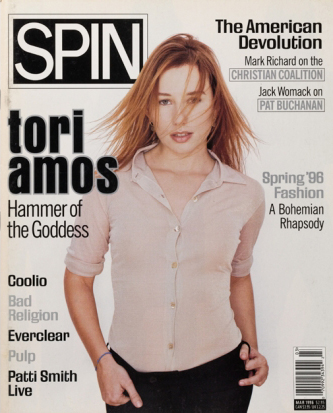
Tori Amos: The Volcano Lover
If you think Tori Amos is just another new age flower poet, wait till you meet the furious girl inside. Francesca Lia Block talks faeries, boys, and pudding with pop music's reigning goddess (Photographs by Corinne Day).
I had a dream about Tori Amos before I met her. She was wearing a stiff
peach damask Italian Renaissance gown; her hair was up on her head, cascading
marinara tendrils. We were walking through an ancient stone castle, discussing
light and darkness, and the way she is often seen as either one or the
other-virgin or whore, ex-classical pianist child prodigy or ex-rock chick,
poet or punk, more the daughter of a Methodist minister father or of a
part-Cherokee mother. When so many contradictions coexist in one petite palace,
there's going to be a cacophony of voices shaking up that dinner party, but
what happens to the lady at the head of the table?
When I actually meet Tori Amos, outside of Surrey, the castle is a pale pink
English country manor with roses clambering up the side and green fields all
around. The damask gown is a fuzzy angora sweater, worn with bell-bottoms and
Mary Jades. But her face is like in my dream, open and friendly, with that
lustrous baroque-pearl skin and generous mouth. Amos kisses my cheeks when I
give her the Sky Dancer doll-a flying plastic faerie-that I brought from F.A.O.
Schwarz in Manhattan. I join her for lunch in a dining room overlooking, through
French doors, a huge lawn and a pool the color of Amos's eyes and sweater. It
feels like I've been hanging out here for a while.
Later, I'm sipping red wine in an attic loft, and listening to the new album
Boys for Pele, named after the Hawaiian goddess of destruction and creation to
whom young men were sacrificed by being thrown into her volcano. Through most
of it, I don't know whether to cry or dance. Amos is dancing around behind me,
and bringing me Kleenex. She has told me, "The
music is the magic carpet that other things take naps on, and I am alternating
between soaring on her tapestry carpet with its elaborate, gold-encrusted
surface and falling into its gorgeous and bloody scenes. I am looking for the
secrets in the hidden patterns, but my guide into this woven world can be as
allusive and abstract as the goddess herself.
"I don't fall in love much," she says. "I mean, I fall in love every five seconds with something
but I don't go from boy to boy. I go from archetype to archetype."
 Her words weave a kind of spell, so that even while you're thinking 'this is
an out-there girl', you're following her down every thickly wooded forest path,
among the roses and the briars, past the carnival mirage in the distance. She
starts to walk slowly in circles with her hand raised above her head as she
talks. "With Caton (Steve Caton, who plays
guitar on Under the Pink and Boys for Pele), we
talked about 'Doughnut Song' and the swirling, the idea of girls on hands of
men and underneath men are slates of material that open up and there are women
underneath them on the backs of cattle and above the girls that are on top of
the hands of men there's something pouring into their water jugs. Those are the
pictures I get when we're trying to find a sound, and it's funny because the
guys go, 'Here we go again - Tori-speak.'"
Her words weave a kind of spell, so that even while you're thinking 'this is
an out-there girl', you're following her down every thickly wooded forest path,
among the roses and the briars, past the carnival mirage in the distance. She
starts to walk slowly in circles with her hand raised above her head as she
talks. "With Caton (Steve Caton, who plays
guitar on Under the Pink and Boys for Pele), we
talked about 'Doughnut Song' and the swirling, the idea of girls on hands of
men and underneath men are slates of material that open up and there are women
underneath them on the backs of cattle and above the girls that are on top of
the hands of men there's something pouring into their water jugs. Those are the
pictures I get when we're trying to find a sound, and it's funny because the
guys go, 'Here we go again - Tori-speak.'"
Deciphering Tori-speak, I learn that the 14 major songs on Boys for
Pele-which at 70 minutes runs much longer than either of her two previous
albums-symbolize the 14 body parts of the Egyptian god Osiris. In the myth,
they were collected by the goddess Isis. If Amos is Isis, whose parts does she
need to collect and reassemble? She recently broke up with Eric Rosse, the
co-producer of Little Earthquakes and Under the Pink, whom she was with for over
seven years.
"Eric and I were inseparable, and the truth is I
don't care any less for him. We just agreed that we needed to go and be
independent of each other. Sometimes I didn't know what was my thought or what
was his, and that's not healthy. We painfully held hands and looked at each
other and said we have to go explore, we can't protect each other anymore. I
miss him of course; you kind of miss it when one of your arms is gone. I mean,
I have a really good left hand and it plays really fast but I do miss my right
arm. I seem to be growing another one, though, and I think he needed his back
so that he could play his instrument."
She also mentions some anonymous other hes who appear on Boys for Pele, but
won't say who they are, though the album is full of references. Amos and her
crew are here at the castle "reeling in the girls,"
Tori-speak for mixing the songs. Songs as girls? The more I listen the more I
get it; the words and sounds are like a girl-party. There are changelings whose
faerie mamas clipped their shivery wings down to the nub in order that they
might pass as human in North Carolina, where they (and Amos) first emerged.
There are goddesses raging in the heart of the volcano, brides in veils
marrying the sun god, sexy tango dancers in the devil's cocktail lounge,
minister's daughters wailing blasphemy in churches, feverish, gun-toting,
swampy Southern belles gone bad with pigs suckling on their breasts. Call them
the girls of Boys.
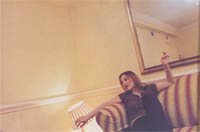 We are walking down a country lane surrounded by hills so green it almost hurts to look at them. This is definitely a land for the faeries, whom Amos
thanks on every album. Her connection to these and other mystical beings is
often perceived as a reason not to take her totally seriously - cute New Age
white-girl flower poet. But really the faerie thing is as much about an eerie
chill that makes every hair on your body stand erect-or about brutal, bloody
violence-as any Sky Dancer image. The original faerie tales were scary, sexy
stories that helped children and adults work out their most primal fears.
Faerie is as much bone and shards of glass and ice crystals sliding down the
spine as it is pretty daisies and dolls (all imagery from Under the Pink; Amos
understands this range). The queen of the faeries, Mab, had red hair and was
buried in a tomb in Ireland, the country Amos recorded much of Boys for Pele
in. Thinking about those curls, that breathy or wailing voice, those sometimes
crystalline, sometimes shattered, shattering melodies and lyrics, I find myself
wondering if this is some kind of pilgrimage to an incarnation of the faerie
queen herself.
We are walking down a country lane surrounded by hills so green it almost hurts to look at them. This is definitely a land for the faeries, whom Amos
thanks on every album. Her connection to these and other mystical beings is
often perceived as a reason not to take her totally seriously - cute New Age
white-girl flower poet. But really the faerie thing is as much about an eerie
chill that makes every hair on your body stand erect-or about brutal, bloody
violence-as any Sky Dancer image. The original faerie tales were scary, sexy
stories that helped children and adults work out their most primal fears.
Faerie is as much bone and shards of glass and ice crystals sliding down the
spine as it is pretty daisies and dolls (all imagery from Under the Pink; Amos
understands this range). The queen of the faeries, Mab, had red hair and was
buried in a tomb in Ireland, the country Amos recorded much of Boys for Pele
in. Thinking about those curls, that breathy or wailing voice, those sometimes
crystalline, sometimes shattered, shattering melodies and lyrics, I find myself
wondering if this is some kind of pilgrimage to an incarnation of the faerie
queen herself.
"I think that people who can't believe in
faeries aren't worth knowing," she says when I bring myself to ask. "Neil [Gaiman, creator of the comic Sandman,
featuring the Amos-based character Delirium] believes
that faeries have gone beyond cool. They've transcended cool. I just think
alternate realities make you a good writer. If your work is any more than one
dimension, you believe in faeries. I'm sure I'll start thinking now about all
the people I know who don't believe, that I quite like. We can still go have a
pint. Not the Chardonnay, though."
We pass some white horses in a field and I ask about another mythical
creature that hasn't been taken seriously. "People
make statements about 'this unicorn shit' and don't realize that 'this unicorn
shit' was a secret code that millions of people were killed for. The gangs
could learn a few things." She's referring to pagan beliefs that
survived through symbolism in tapestries and literature. "If you weren't toeing the Catholic line at the time,
then you were a heretic. I'm trying to reconstruct some of these falsehoods"
Suddenly, she's had enough of theories and abstractions. Modern-day-Mab wants
to go into the small nearby town to get the herbal pickup, guarana, for the
crew: "Kind of a naughty faerie thing to do."
Much of Boys for Pele stems from Amos's response to what she believes is "one of the greatest lies that has been told, the lie
about the sacred bride and the sacred bridegroom." Originally, Jesus was
the sacred bridegroom, but the bride -- or goddess -- and her cults were wiped out by
Christianity- making Mary Magdalene a whore instead of a priestess and taking
away the Madonna's sexuality. "There's not a sacred
bride in our culture." Amos says her life would have been different,
that she would be less oppressed by shame about her passion and sensuality, if
she had been raised with the sacred myth intact.
"We kind of skulk off into the darkness to
fulfill these sides of ourselves. We get tied up or defecated on because we've
judged our true desires as women so harshly." If the bride had been
acknowledged, she argues, "there would have been
honor of the feminine. There wouldn't have been patriarchy as we know it or
matriarchy. There would have been balance."
This idea also applies to rock. "If you look at
rock culture, there is very much a desire for the sacred bridegroom to die. The
sacred brides don't die much. Janis Joplin is one of the very few."
In her song "Muhammed My Friend," Amos honors the bride with the lines,
"It's time to tell the world, We both know it was a girl back in Bethlehem."
You can just see a torrid Tori-video with a girl in a skimpy red dress stepping
off the cross and dancing into the distance.
All of this myth-speak isn't an abstraction for our sacred girl. "Even if you don't read history or you aren't interested
in anything that happened before the '60s, there are reasons why we think the
way we do. There are reasons why people are going crazy right now."
Paraphrasing Joseph Campbell, she says: "A culture
that doesn't know its mythology is powerless. Some kids show up at my shows
crawling out of their bodies. They'd turn their power over to anything; that's
'cause they don't know the tools to go in."
The tools are the myths themselves. Without them, we won't be able to
understand who we are. This tapestry will dissolve, the faeries will be
silenced, white horses will lose their horns, and the goddess will become the
frightened girl forever. The more you live inside Tori's tapestry, the more you
realize how necessary it is to keep the golden threads of myth intact.
"I wanted to marry Lucifer," she tells
me. "Even though I had a crush on Jesus. Lucifer
was the brother holding the space for mankind/womankind to act out their fears
and hidden secrets, things they won't acknowledge. That's what the shadow is,
the side that's been denied, and once you don't deny your shadow anymore then
it's not a perversion of that energy source. I don't consider Lucifer an evil
force. We can all tap into that free-running current of distorted energy.
"Some of my girlfriends -- liberal London girls -- had
a problem with the idea that I was writing a song called 'Father Lucifer.' One
of them heard it and cried and said, 'You made him so beautiful,' and I said,
'What if he is beautiful?' Shadow defines light. The shadow is where I hang out
a lot because I like chasing and diving with those forces."
I mention the Greek myth of Persephone, the girl stolen away by Hades, god
of the underworld, and how she might have preferred that fate to hanging out
with her mother among the flowers and sunshine forever.
Amos replies, "Although I think my mom would
like to tag along and have a dance with him because she's been a minister's
wife for so long! But this is not Hollywood's view of Lucifer."
Instead of an evil satanic demon, her Lucifer is a dark god who has great
respect for life and love. "On some of my darkest
days, he's the one that comes and gives me an ice cream. I feel such a sadness
from him. I cry and feel his presence with his music. I feel like he comes and
sits on my piano. Yet this is a pretty serious being. I'm a little squirt when
you think what a very serious force this is."
Sounds pretty heavy, but "Father Lucifer" is as much a romantic fantasy as anything else. "I just always wanted to learn flamenco so I could dance with him," Tori teases. "I wanted a great tango in the June summer with somebody really hot. There are a lot of cute boys around. It's that quirk in their personality that makes my toes curl, and Lucifer's got a very quirky personality."
And just as she loves the darkness, she craves the light: "I flirt with the sun god too. I enjoy that immensely." She gives her "yummy" smile, like a little girl with a bowl of pudding, a food
that comes up quite often with her. "In fact, I enjoy both of them quite immensely."
"Tori is a foody," her assistant, Kerri Manuell, has told me. And it's true. Tonight is Halloween and we dine by candlelight on salmon steaks, potatoes, sweet potatoes, broccoli, home-baked bread, apple raspberry crumble, and the Chardonnay she loves and might not share with you if you don't honor alternate realities.
Amos uses food as a way to talk about everything that isn't food. Searching for a sound on "Marianne," a song about a childhood friend who died, she told her musicians "It's kind of like that melon slush that I made ten years ago and poured it out the side of my little hovel when I lived in L.A."
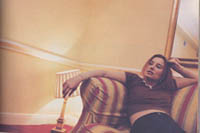 Food is how she explains the status of her record label: "When it's time, that information will be made available,
but right now I think it's good to let the bread bake in the oven. There's
definitely some muffins in the oven." It's how she expresses her desire
to care for people -- "Anorexics need to hang out
with me. I know the finest chefs. I do! I've had a few propose marriage and
everything!" -- and how she describes her harpsichord: "I really was getting a bit bored with the piano;
compositionally I just needed a new taste, kind of like another spice, so I got
into the red pepper. Cayenne pepper. Cayenne pepper in orange juice, cayenne
pepper in spaghetti, cayenne pepper in pudding, and this is what the
harpsichord has been." In fact, when I ask her to define her core
beliefs, she doesn't have to think. "Lots of food!"
Food is how she explains the status of her record label: "When it's time, that information will be made available,
but right now I think it's good to let the bread bake in the oven. There's
definitely some muffins in the oven." It's how she expresses her desire
to care for people -- "Anorexics need to hang out
with me. I know the finest chefs. I do! I've had a few propose marriage and
everything!" -- and how she describes her harpsichord: "I really was getting a bit bored with the piano;
compositionally I just needed a new taste, kind of like another spice, so I got
into the red pepper. Cayenne pepper. Cayenne pepper in orange juice, cayenne
pepper in spaghetti, cayenne pepper in pudding, and this is what the
harpsichord has been." In fact, when I ask her to define her core
beliefs, she doesn't have to think. "Lots of food!"
"I just have to have a giggle sometimes because
these relationships are so overblown. You know the pudding that never stops
growing? Like tapioca... you could forge houses in it."
Even with her lust for life and funny puddings, Amos habitually deals with images
as rippingly painful as "chickens get a taste of your meat," in the Boys song
"Blood Roses." "Let go and love,' Fuck that shit!
My heart is scarred. I have a tear running down the middle of it and I'm not
ready to say, 'Let go and love.'"
But the pain on her new album seems less like the pain of victimization that
we witnessed on Under the Pink and more the growing-up pain of self awareness. "It's not a revenge record but a releasing record. I've
been angry at myself, too, for getting into certain situations with men. Anger
is healthy, but out of balance if it doesn't have compassion."
One of the girls on Boys is "Hey Jupiter," a song about the pain of separation
that Amos says is very much about a real man. "I was
at my lowest. I was at a hotel in Phoenix, and I realized that for once there wasn't
a man I could turn to." The song contains lines from inside the sorrows
of a breakup, words that encapsulate a lot of what the album represents: "So
are you gay? / Are you blue? / Thought we both could use a friend to run to."
But this is only part of the story. She also quotes from the driving, bitter
bang of a song, "Professional Widow": "'Give me
peace, love, and a hard cock': because you can't have one without the other.
For her to really say, 'Are you gay? / Are you blue?' that same person has had
to say 'Give me peace, love, and a hard cock,' because if I hear peace and love
one more time! That is so full of shit!"
Seething with a rage made visceral by the baroque but violent sounds of the harpsichord, "Professional Widow" has an anger and power that we've rarely, if ever, heard from her before. "Slag pit / Stag shit / Honey bring it close to my lips / ...Starfucker, just like my daddy." Speaking about her furious girl, Amos says, "I really like her because she's dead honest. I've been a groupie and I wish I hadn't been, but I was and it happens. I can relate."
"And now you're on the other side," I say.
"No, I've been a groupie when I was on the other side, actually."
"Do you sometimes use abstractions or obscure references to give yourself a little
distance from such specific events?" I ask. We are curled up on a couch
drinking tea. Outside, the grounds are veiled in furtive, silvery light.
"I don't think Boys for Pele is abstract at all. I
think Under the Pink was an abstract work; it was meant to be. This one is more
like when you're in a relationship where there are things that are hidden but
are definitely underlying the conversation; you're interrogating him -- over a
glass of red wine and a fire, but you're still trying to get information. And
you feel more than one thing at one time.
"Poppa [her part-Cherokee grandfather] always said the South was so confusing because the South
smells the sweetest after a lynching. That's because after a lynching the
goddess cries and the honeysuckle never smelled sweeter. That's similar to
relationships. You're sitting there thinking one thing and hearing one thing
and yet he's telling you another thing. It's like, what was that about not
being able to commit himself? He said it without saying those words, he said,
'My mind is divided, I want to come see you but my mind is divided.' Give me a
fucking break. But I'm buying this -- I wanted to hear his mind was divided so I
could hang on a little longer. And this is many he's -- my whole life."
I ask about the choice of finishing up the album in Louisiana. "At first I was going to record everything in the South.
There's a hiddenness about the South, and I wanted to go back there because it
was similar to how I felt in my relationships with men." The Southern
girl wanted to convey the buried meanings that often haunt love relationships,
by working in an environment that is so much about cruelty disguised by rich,
sensual beauty. "Things smell so delicious coming
from that oven, the lazy summer days and the grasshoppers and the honeysuckle
and the magnolia, the rhododendrons. You don't want to see how cruel people are
being to each other. It's much more harsh because they're in this impressionist
painting, so everything is muted, even though it's shockingly out of order.
It's very much like the relationships. Everything looks as if there's this
beauty and then we would be doing things to each other that were far from
beautiful."
In this tapestry castle is a room I glimpse but don't go into -- the sacred temple
that houses the piano and the harpsichord. One difference between Boys and the
earlier albums is the presence of the harpsichord, which Amos learned to play
specifically for this venture. Because it has no sustain, it is very different
from the piano, and she's been "playing it more
like a percussive instrument. I got into my thrash harpsichord. When I look at
it, I just see it go to me, 'Wear your high-heeled red shoes and give me some ass,
girl.'"
Amos is obsessed with finding unique sounds. "I'm a hunter," she says. "I'm not much of a collector but I have a really hard time not collecting shoes."
Her confidence as a musician is truly of goddess proportions. And she should
be confident, selling out every venue to screaming audiences who recall Beatles
fans in their hysteria even though she's just one girl and a piano. But she
catches me off guard by suddenly expressing her vulnerabilities. Ironically,
since many people are frustrated that they aren't taken seriously as musicians,
Amos struggles with wanting to be appreciated as a woman first.
"You've got to remember I was playing since I
was a little girl. I've been a musician before I was a human. I've always been
judged musically before I even knew what was happening just because that's what
happens when you're playing at such a young age. But now there really is a
person inside here other than the musician, and I'm just coming to that this
year. Music is so much a part of me I think it's in my cells. If I lost my
hands and I lost my voice and I was just sitting there I'd still think in tone
and rhythm because that's how I think every second. But I can be a woman that
thinks in tone and rhythm, not just this thing."
As Amos figures it, "This is where a lot of Boys
for Pele is coming from. It's not [about] pushing
the boys off the side of the volcano or roasting them with marshmallows. There
were five seconds when that did occur to me, but that's just because I wasn't
really ready to see the gift. I think these relationships are such gifts."
So what happens to the girl who is all these girls? How does she integrate the fragments? How does she resolve her anger toward the boys?
"It's very much working with that Pele energy, that destruction/creation energy, trying to find the balance, because I would find myself either the lovey-doveyest-woviest sweet pea, or a madwoman," Amos says. With hard work, self-awareness, analysis, and expression, she is bringing all her fragments together. And she has something else that helps, too -- her appetite for the humor in life. She interrupts all the analysis with "I think the Brits would laugh their asses off and go, 'Tori, you have to go to a rugby match.'"
I realize that I like her even more than I'd imagined I would. This isn't just about worshiping at the temple of the goddess. It's about sharing pudding secrets with a girlfriend.
"This is an interview, so I'm speaking to that boy out there who feels like he's been shit on by this girl. I'm speaking to that girl out there who will never get approval from her father-it ain't going
to happen, she's never enough. I know how many kids this reaches, but at the same time there is a balance to all that search for wholeness and part of that is going to the rugby game. Diversity creates wholeness."
We stop in front of the house. She is lighting and extinguishing one match after another.
"And what about the Pele reference?" I ask. "When and how did the album come to be called that?"
"I'm a bit of a pyro and I ran out of matches when I was staying in Hawaii."
Pianos for pyros, I think.
Back at the house, Amos tells me about her upcoming tour, in which she will do some 180 appearances in one year. I'm reassured to know that she will have her best friend, Beenie Shanks, who also does Amos's body work, along, as well as her kindly, protective road manager John Witherspoon, her loyal quirky-angel crew, and a chef specializing in gourmet Asian cuisine. Still, it's tough work under any circumstances, even for a girl with "warrior energy" who has told me, "If we were a pile of Vikings, I'm not a bad guy to have on your side."
When I'm about to leave, she hugs me.
"See you around the bend," she says. I'd like to go with her. But instead I'll imagine her flying across continents, alighting at the best restaurants for her savory favorite meals of wild mushrooms and fish cooked on wood planks, the finest Chardonnays; collecting shoes with seven-inch heels in Paris; I'll imagine her crying in hotel rooms in the Midwest and sweating at her harpsichord, lit by the faces of thousands of the devoted. She is in Hawaii, playing her piano at the edge of a volcano, embodying (with typical dualism) both the flame and the ash. It is impossible to tell where one ends and the other begins.
original article
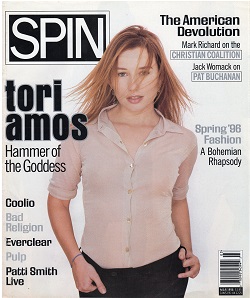 
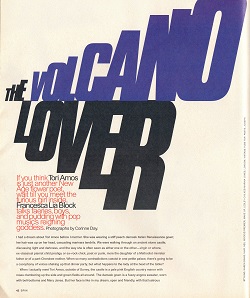 
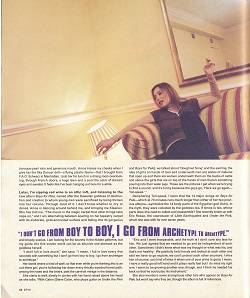 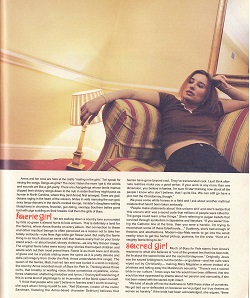
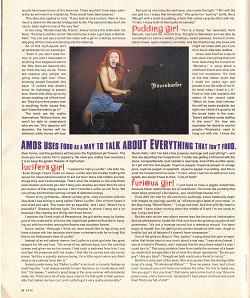 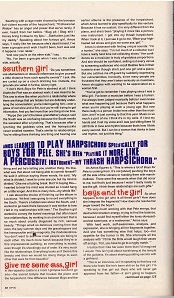
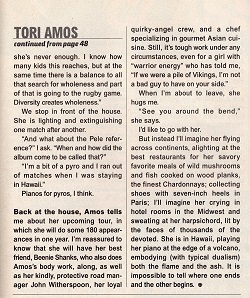
[scans by Sakre Heinze]
t o r i p h o r i a
tori amos digital archive
yessaid.com
|